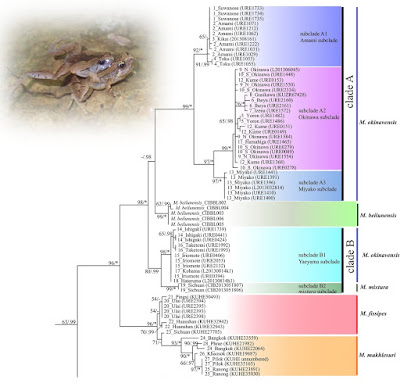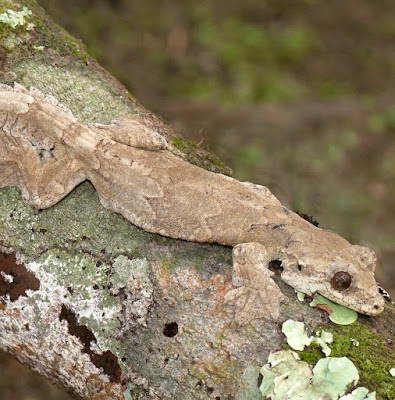[Most Recent Entries] [Calendar View]
Tuesday, July 16th, 2019
| Time | Event | ||||
| 7:04a | [Herpetology • 2019] Relict Distribution of Microhyla (Amphibia: Microhylidae) in the Ryukyu Archipelago: High Diversity in East Asia maintained by Insularization
Abstract The Ryukyu Archipelago, located at the southwestern part of Japan, is known as a group of continental islands and harbours many endemic taxa, supposedly reflecting its fairly long isolation from the Eurasian continent, Taiwan and the Japanese main islands. Microhyla okinavensis has been known as an endemic member of the terrestrial fauna of this archipelago. Molecular phylogenetic analyses using samples from nearly all island populations of the species and representative samples of other east Asian congeneric species revealed that M. okinavensis consists of four distinct subclades, of which the Amami, Okinawa and Miyako subclades, though exhibiting distinct genetic differentiations from each other, formed a monophyletic group (clade A). The remaining Yaeyama subclade was exclusively sister to M. mixtura from inland China, forming another monophyletic group (clade B), rendering M. okinavensis in the current definition paraphyletic. These results, as well as estimated dates of divergence from related taxa, indicate that M. okinavensis actually includes more than one distinct species. The results indicate that M. okinavensis and M. mixtura are relict species with disjunct distributions which had been most probably caused by invasion of M. fissipes in intervening areas. Keywords: Continental Island, East Asia, Microhyla, phylogeography, relict lineage
Atsushi Tominaga, Masafumi Matsui, Naoko Shimoji, Wichase Khonsue, Chi‐Shiun Wu, Mamoru Toda, Koshiro Eto, Kanto Nishikawa and Hidetoshi Ota. 2019. Relict Distribution of Microhyla (Amphibia: Microhylidae) in the Ryukyu Archipelago: High Diversity in East Asia maintained by Insularization. Zoologica Scripta. 48(4); 440-453. DOI: 10.1111/zsc.12361 | ||||
| 9:14a | [Herpetology • 2019] Ptychozoon cicakterbang, P. kabkaebin & P. tokehos • Geographic Structure of Genetic Variation in the Parachute Gecko Ptychozoon lionotum Annandale, 1905 Across Indochina and Sundaland with Descriptions of Three New Species
Abstract An integrative taxonomic analysis of the Ptychozoon lionotum group across its range in Indochina and Sundaland recovers P. lionotum sensu lato Annandale, 1905 as paraphyletic with respect to P. popaense Grismer, Wood, Thura, Grismer, Brown, & Stuart, 2018a and composed of four allopatric, genetically divergent, ND2 mitochondrial lineages. Multivariate and univariate analyses of continuous and discrete morphological and color pattern characters statistically and discretely diagnose each lineage from one another and together, with maximum likelihood and Bayesian inference analyses, provide the foundation for the recognition of each lineage as a new species—hypotheses corroborated with a Generalized Mixed Yule Coalescent species delimitation analysis. Ptychozoon cicakterbang sp. nov. ranges throughout Peninsular Malaysia to Pulau Natuna Besar, Indonesia; P. kabkaebin sp. nov. is endemic to northern and central Laos; and P. tokehos sp. nov. ranges from southern Thailand south of the Isthmus of Kra northward to Chiang Mai, fringing the Chao Phraya Basin and ranging southward through Cambodia to southern Vietnam. Ptychozoon lionotum sensu stricto ranges from northwestern Laos through southern Myanmar to eastern India. The phylogeographic structure within each species varies considerably with P. lionotum s.s. showing no genetic divergence across its 1,100 km range compared to P. cicakterbang sp. nov. showing upwards of 8.2% sequence divergence between syntopic individuals. Significant phylogeographic structure exists within P. tokehos sp. nov. and increased sampling throughout Thailand may require additional taxonomic changes within this species. Keywords: Reptilia, Asia, Gekkonidae, gliding, integrative taxonomy, phylogeography, species complex Ptychozoon cicakterbang |
| << Previous Day |
2019/07/16 [Calendar] |
Next Day >> |






